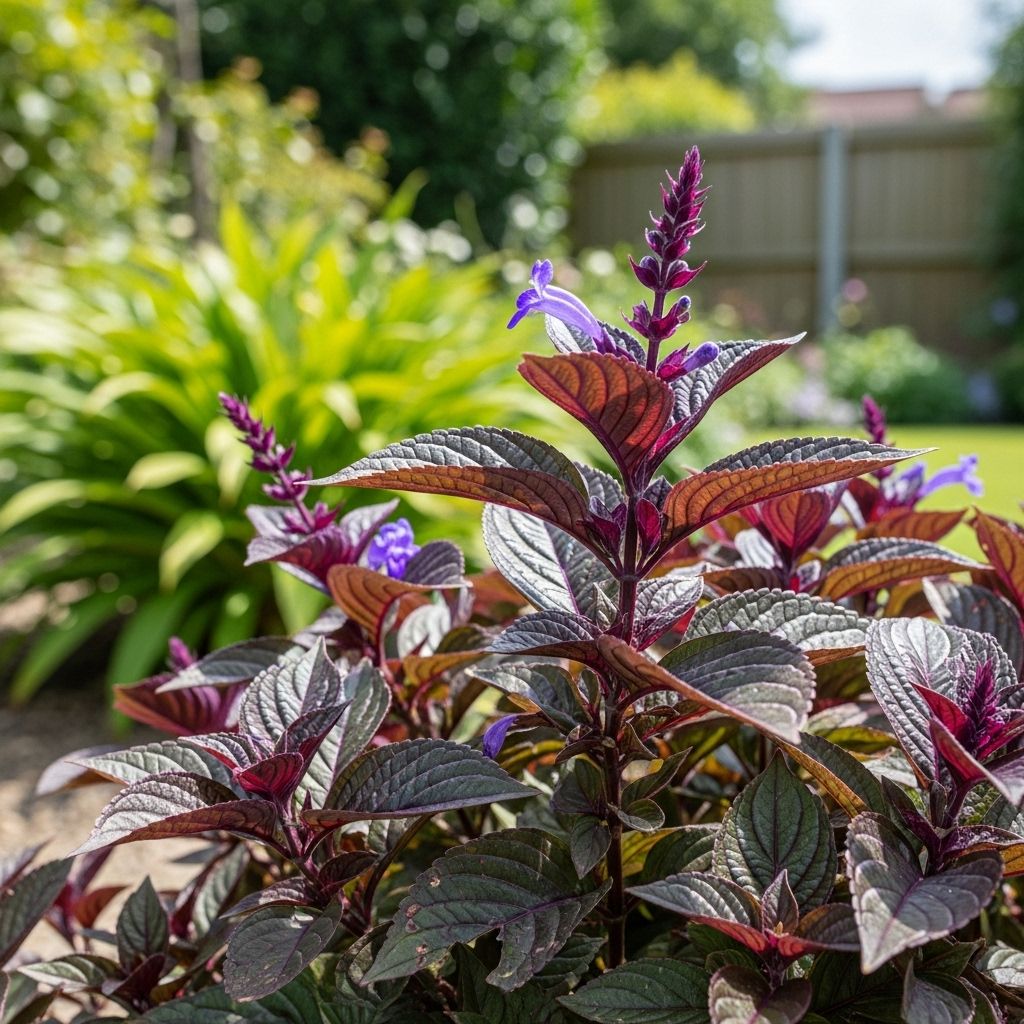How to Plant, Grow, and Care for Persian Shield
Metallic-hued leaves deliver an instant focal point in containers, beds, or bright rooms.

If you’re searching for a showstopper with vividly colorful leaves for your home or garden, Persian Shield (Strobilanthes dyerianus) is an unbeatable choice. Its shimmering, iridescent purple foliage steals attention wherever it’s planted, thriving as both a backdrop and a focal point in beds, borders, and containers. This comprehensive guide explains everything you need to know about Persian Shield care, from planting to maintenance, propagation, and troubleshooting.
What Is Persian Shield?
Persian Shield is a tropical, evergreen sub-shrub native to Myanmar (formerly Burma) in Southeast Asia. Introduced to Victorian gardens for its ornamental foliage, it’s valued for its:
- Iridescent purple, silver, and green leaves that have a metallic sheen in the light
- Lance-shaped foliage with prominent veining and toothed edges
- Solid purple-maroon undersides to the leaves
- Growth up to 3-5 feet tall and 2-3 feet wide in ideal hot, humid conditions
This plant belongs to the acanthus family (Acanthaceae) and is known botanically as Strobilanthes auriculata var. dyeriana or simply Strobilanthes dyerianus.
Growing Persian Shield: Annual, Perennial, or Houseplant?
Persian Shield is a perennial in USDA Hardiness Zones 10–11 but commonly grown as an annual or brought indoors as a houseplant in cooler climates. Its native habitat provides:
- High temperatures and humidity
- Bright, indirect sunlight
- Consistently moist, but not waterlogged, soil
In temperate regions, Persian Shield showcases its impressive foliage throughout the summer and can be overwintered indoors.
Benefits & Design Appeal
- Striking color for garden borders, containers, or houseplant collections
- Stunning accent in mixed plantings with contrasting variegated or lime-green foliage
- Retains its ornamental value throughout the growing season—even when other flowers decline
Plant Care Essentials
Persian Shield is not high maintenance, but it responds best to the right conditions. Below are the core care factors to ensure its success:
Light Requirements
For optimal color and growth, provide:
- Bright, indirect light outdoors—morning sun with afternoon shade is ideal
- Bright spot indoors—near an east- or west-facing window, avoiding direct midday sunlight that can scorch leaves
If the plant receives too little light, it may become leggy and lose vibrancy. Too much intense sun can bleach the leaves.
Soil Preferences
- Well-draining, nutrient-rich soil is essential to prevent root rot and provide a healthy base
- Add compost or organic matter at planting to enhance drainage and fertility
- pH preference is neutral to slightly acidic (6.0–7.5)
Check regularly to ensure soil does not become compacted or depleted of nutrients over the growing season.
Watering Routine
- Keep soil consistently moist but never soggy
- In hot weather, water more frequently to prevent heat stress and wilting
- Reduce watering in cooler months to avoid waterlogging
- Never allow soil to dry out completely but avoid watering to excess
Avoid letting leaves wilt excessively—while they recover quickly, repeated wilting reduces vigor and leaf quality.
Humidity and Temperature
- High humidity (above 50%) is crucial—dry air leads to leaf drop and pest issues
- Ideal temperature: 60–85°F (16–29°C)
- Keep away from air conditioning or heating vents indoors which reduce humidity
To increase humidity indoors:
- Place a tray of water and pebbles beneath the pot
- Group plants together
- Use a humidifier
Fertilizing
- Apply a balanced, water-soluble fertilizer monthly during spring and summer
- Reduce or stop fertilizing in fall and winter as growth slows
- Follow label instructions to avoid fertilizer burn
Pruning and Pinching
- Pinch young stems regularly to promote bushiness and prevent legginess
- Remove faded or damaged leaves to keep plants attractive
- Trim back periodically to control size, particularly in containers or indoors
Planting Tips
Plant Persian Shield outdoors only after the danger of frost has passed and soil has warmed. For best results:
- Amend planting site with compost for improved texture and nutrients
- Water thoroughly after planting and mulch to retain moisture
- Select a partially shaded spot for intense leaf color
Growing Persian Shield Indoors
Persian Shield can flourish indoors with proper care:
- Place in a bright, non-drafty location—close to an east or west window
- Humidity trays or misting help combat dry indoor air
- Rotate plant for even light exposure and symmetrical growth
- Be vigilant about watering and avoid letting roots sit in water
Use a good quality, well-aerated potting mix and a container with a drainage hole.
Outdoor Use: Flower Beds and Containers
- Display Persian Shield as a dramatic accent in mixed beds, borders, or large containers
- Combine with silver, lime-green, or chartreuse-leaved companions for a dazzling effect
- Protect from midday sun to prevent leaf scorch
Propagation: How to Multiply Your Persian Shield
Persian Shield is easy to propagate and often benefits from renewal through cuttings. Here’s how to do it:
Stem Cuttings
- Cut a 4–6 inch non-flowering stem just below a node, preferably in spring or early summer.
- Remove lower leaves, leaving a few pairs at the tip.
- Dip cut end in rooting hormone (optional) and plant in moist, sterile potting mix or damp sand/perlite.
- Cover with a plastic bag or use a propagation dome to maintain humidity.
- Place in bright, indirect light—roots should form in 2–4 weeks.
Water Propagation
- Root stem cuttings in a glass of water, changing water every few days until roots appear
- Transplant to soil once roots are 1–2 inches long
Regular propagation is advised, as older plants can become woody and lose the best leaf color.
Pests and Problems
Persian Shield is generally trouble-free, but can encounter a few challenges:
Common Pests
- Spider mites: Thrive in dry air. Look for fine webbing and tiny moving dots on leaves; increase humidity and wash off with a gentle shower or insecticidal soap if infestation occurs.
- Mealybugs: Appear as white, cottony masses. Remove by dabbing with alcohol on a cotton swab and treat with neem oil.
- Whiteflies and aphids: Occasionally affect indoor plants—rinse off and use horticultural oil or insecticidal soap as needed.
Diseases
- Root rot: Caused by waterlogged soil or poor drainage. Avoid overwatering and ensure well-draining soil.
- Leaf drop: Typically a response to dryness, low humidity, or underwatering.
Persian Shield Quick Care Table
| Aspect | Details |
|---|---|
| Light | Bright, indirect; morning sun or filtered light |
| Soil | Well-draining, rich in organic matter |
| Water | Keep soil consistently moist, never soggy |
| Humidity | High (50%+ preferred) |
| Fertilizer | Balanced, water-soluble monthly during growing season |
| Hardiness | USDA zones 10–11; treat as annual or houseplant elsewhere |
Frequently Asked Questions (FAQs)
Q: Can Persian Shield be kept indoors year-round?
A: Yes, Persian Shield grows well indoors if given enough light, warmth, and humidity. It may need extra attention in winter when indoor air gets dry.
Q: Why are my Persian Shield’s leaves dull or losing color?
A: Faded color results from low light, old age, or cool conditions. Move the plant to brighter light, propagate new cuttings from healthy stems, and keep conditions warm and humid.
Q: Can Persian Shield survive a light frost?
A: It may withstand mild frost briefly, but persistent freezing temperatures will kill it. Move plants indoors or take cuttings before frost in colder climates.
Q: How do you encourage bushier growth?
A: Pinch the growing tips regularly and prune back leggier stems to stimulate bushier foliage.
Q: Can Persian Shield flower?
A: Persian Shield does produce clusters of small violet flowers, most often in maturity or when overwintered, but the foliage is the primary decorative focus.
Final Tips for Persian Shield Success
- Monitor soil moisture and never let it dry out completely
- Boost humidity—especially indoors or in dry climates
- Refresh with regular cuttings for maximum vibrancy year after year
- Protect from direct, harsh midday sun and cold drafts
With these tips, you can enjoy the lush, metallic shimmer of Persian Shield whether you garden indoors or out.
References
- https://www.epicgardening.com/persian-shield/
- https://www.youtube.com/watch?v=EiJpbxcT7E8
- https://www.uaex.uada.edu/yard-garden/resource-library/plant-week/persian-shield-10-16-09.aspx
- https://hort.extension.wisc.edu/articles/persian-shield-strobilanthes-dyerianus/
- https://www.youtube.com/watch?v=9sX7NNWa184
Read full bio of Srija Burman












